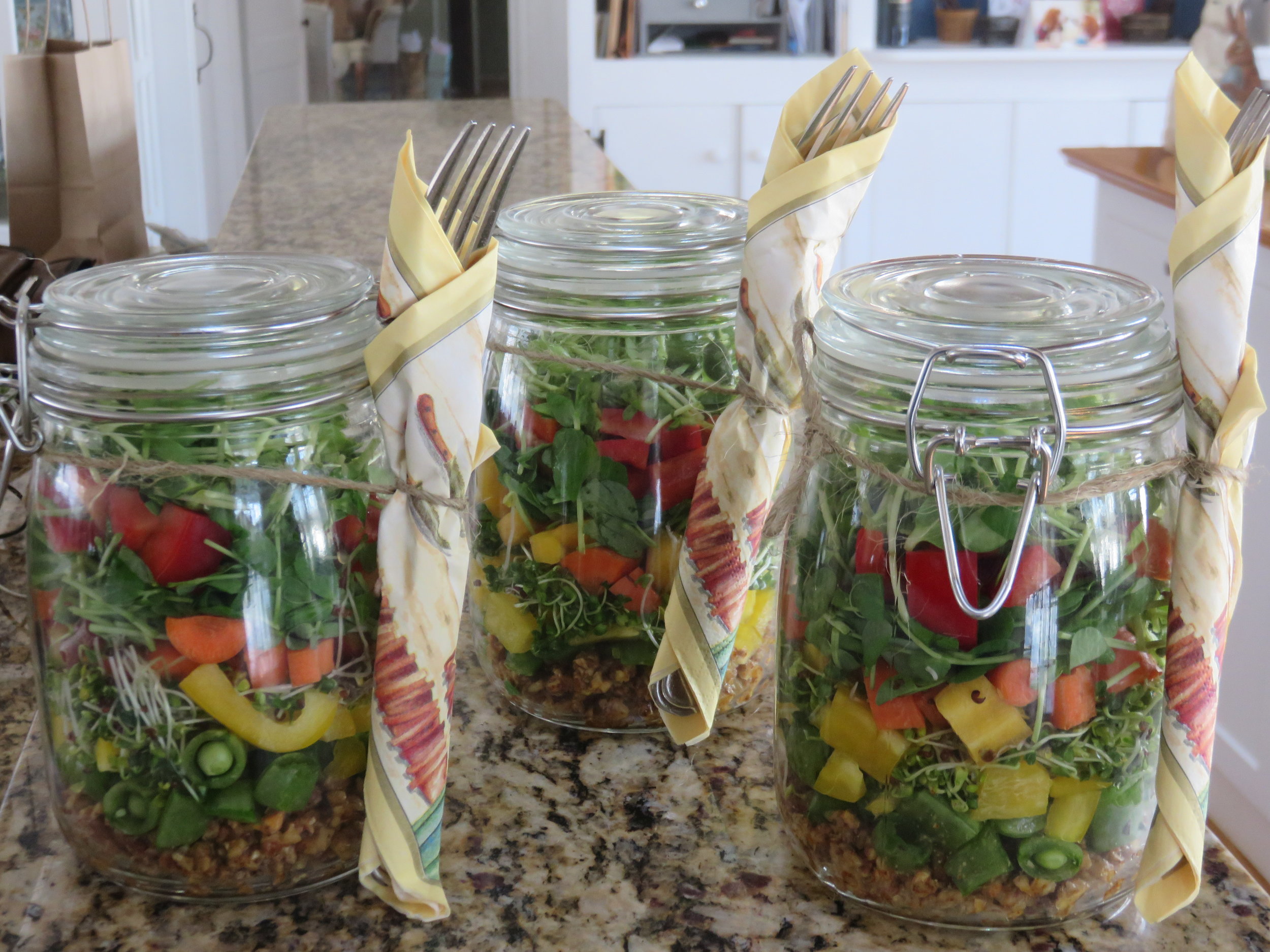Food for Thought: Add Some Color to Your Plate!
As Seen in Haddam-Killingworth Now
(May 18, 2019) — Consuming a Rainbow of Color adds years to your life and looks oh so pretty on your plate! Colorful fruits and veggies are jam packed with vitamins and minerals. All of these vitamins and minerals not only help clean-up your insides, all of the antioxidants and phytonutrients help prevent free radicals, they remove toxins, and help to douse the flames of inflammation.
Each color offers different nutrients, like the lycopene in tomatoes, the carotenoids in sweet potatoes and carrots, or the anthocyanin in blueberries. Nutritionally, these plant pigments go to work in your body reducing the risk of heart disease, type two diabetes, and cancer, among other illnesses. The phytochemical known as allicin, which is found in garlic, provides wonderful protection from viruses and bacteria.
Make ¾ of your plate an array of colorful veggies at each meal. The serving recommendation has always been 5-9 servings of fruits and veggies a day, but for the greatest benefits go for 10 a day! It is always a good idea to rotate your selection and your colors to gain the most variety of nutrients! Visit your local farmers market and try something new! Start with whole foods, preferably organic (check out EWG’s clean fifteen and dirty dozen list HERE). Fresh and frozen are best, but canned (BPA fee cans) will do in a pinch. Avoid pre-prepared veggies and fruits as they often have syrups, sauces, and preservatives added, which is not the healthiest option. Remember to read the stickers on your whole foods. If the label starts with a 4 it is conventionally grown and may contain pesticides and sprays. If the label starts with a 9 it certified organic. If it starts with an 8 it is a GMO food and most likely contains Round-up, which is highly toxic to your body.
Although fruit has great nutritional value, it also has natural fructose which can raise blood sugar. There are high sweet fruits like pineapple, bananas and mangos; medium sweet fruits like apples, peaches, pears, and plums; and low sweet fruits like berries which are filled with vitamin C, potassium, fiber, and flavonoids. Fruit is best digested on and empty stomach and not with other foods, but for special occasions it can become a wonderful treat or delicious dessert. Two of my favorites are a Berry Crisp and Chocolate Drizzled Strawberries!
It is important to consider the seasons in purchasing and preparing your veggies and fruits. In warmer weather months, consuming raw fruits and vegetables will provide super nutrients and help to keep you cool. In the cool weather months, it may be best to steam, sauté, simmer, bake, broil, or roast your seasonal produce to keep you warm! Keep in mind that we are all different and if your digestive track is out of balance it may not tolerate raw vegetables no matter the season. Adding herbs and healthy sauces will change a boring meal into a wowza meal! Try taking the same food and preparing it in different ways – need ideas, just email me at connect@roots2wellness.com.
Eating seasonally and buying locally is the best way to keep your circadian rhythm in balance. This will vary based on your geographic location and your climate. Some areas experience four seasons while others only have two seasons. Chinese medicine and the Ayurvedic philosophy are big into eating based on weather, climate, seasons, etc. It makes sense if you live in a hot climate to eat cooling foods and if you are in the dead of winter to eat warming foods. Eating cold smoothies and too many raw foods in cold weather can disrupt your circadian rhythm and throw you off balance causing an assortment of symptoms like digestive issues, fatigue, insomnia, achy joints, etc. These little signs and symptoms can lead to bigger issues down the road if they continue and are ignored for too long. Listen to what your body is telling you. When you buy local foods from your farmer’s market, you will be eating what is in season at that time. Consider joining a CSA (Community Supported Agriculture) to get a share of local veggies, fruits, and herbs.
Our plant kingdom is so smart! Greens that grow in the spring time are wonderful for cleansing our bodies from the sluggishness of winter. Watermelon, berries, and cucumbers keep us cool in the heat of the summer. Apples, pumpkins, and cranberries in the fall prepare our bodies for the cold season to come. Root vegetables keep us grounded and hearty winter squash warms the bones in cold winter months. Also consider spice for cooling and warming the body. We commonly use warming spices like cinnamon, gloves, ginger and allspice in the cooler months and dill, basil, and cilantro in the warmer weather. Isn’t it fascinating how this amazing plant kingdom provides for us just what we need when we need it?
If you are dealing with a lot of inflammation, you may want to consider eliminating nightshade vegetables for a month to see how you feel. Then add one at a time and make a note of any symptoms or flare-ups of inflammation. Folks with arthritis and joint issues have had good results when they stop eating veggies in the nightshade family. They include potatoes, peppers, tomatoes, eggplant, etc. A more comprehensive list can be found online.
As you begin to add more plants to your daily diet, consider trying a “Meatless Monday” and making all plant-based meals for a day. For special occasions be the person who brings a plant-based dish to share – make it engaging and fun, especially for the children. Adding these colorful nutritional powerhouses to your daily diet will having you looking and feeling better in no time. So get out to your local farmer’s markets and find some colorful treasures!
Very Veggie Lasagna
This is a great gluten free and dairy free recipe for lasagna lovers!
2 medium zucchini
2 medium yellow squash
8 plum tomatoes
2 portabella mushrooms
1 vidalia onions
3 cloves of garlic
3 Sprigs of fresh basil & oregano
Salt & pepper to taste
3-4 Tbs. olive oil
Cashew Cheese (see recipe below)
Alternate slices of green zucchini and yellow squash, cut thinly the long way.
Next, add a layer of sliced red plum tomatoes, sliced brown portobello mushrooms and chopped onion and garlic.
Then, add a layer of fresh green herbs and then sprinkle with sea salt, pepper, and olive oil.
Add a layer of cashew cheese.
Repeat the above process two or three times, depending upon the depth of the pan. Finish the top layer with extra tomatoes, whole cashews, more herbs, and then drizzle with olive oil.
Bake at 350 degrees for about 30-45 minutes, until warm through and veggies are tender. Enjoy!
NOTE: You can swap veggies and use eggplant instead squash and zucchini.
Cashew Cheese:
2 cup raw, unsalted cashews
½ cup nutritional yeast
2 Tbs. lemon juice
2 Tbs. water
Soak cashews in a jar of water overnight. Drain cashews in morning and place them in food the food processor. Add the nutritional yeast, then just enough water and lemon juice to make it moist. Add the sea salt and pepper to taste.
Kitchen Sink Soup
It’s always great to cook once, and eat two or three times. I love to repurpose food. Start by chopping a rainbow of colorful veggies with different tastes & textures.
You can use some of the veggies as a snack, add them to your salad for lunch, or as a side dish for your dinner. And of course you can add your veggies to soup!
4 cups of water, or veggie broth.
3-4 Tablespoons of Miso (a fermented soy typically found in the produce isle).
2 cups of veggies you have on hand.
Sea salt, pepper, herbs and olive oil to taste.
Simmer for 30 minutes on medium heat until veggies are slightly tender. So easy, so delicious and so amazing for you! Use an emersion blender or hand held masher for a creamier soup. This works well with cauliflower, broccoli, and/or sweet potato soups. You can make a big batch and freeze half for leftovers or cut the recipe in half.
Salads on-the-go
These Mason jar salads can be made on a Sunday and will last about 4 days. Chopping everything on a Sunday and prepping the jars is a great way to keep a healthy salad handy for a busy week.
Choose a legume, like chickpeas, or cooked quinoa. Another option is walnut taco meat (pulse walnuts in food processor with Braggs amino acid, lemon, and chili powder).
Dressing of choice (simple recipe: Braggs amino acid, lemon juice, sesame oil, and grated or ground ginger). If using walnut taco meat, do not add dressing.
Chopped veggies of choice
Sprouts & microgreens
Place the first ingredient at the bottom of the jar. Add your dressing. Begin layering one veggie at a time, starting with the harder veggies first. Top with the sprouts and microgreens. Wrap a fork in a napkin and tie it to the jar with some twine and you are set to jet.
Collard Green Wraps
This is a great way to enjoy a quick bite that is packed with a rainbow of colors, it is very satisfying, and is easy to make ahead, leaving you with lots of energy!
Collard Greens, lower stems removed
Add a slice of soft green avocado for a good fat source & Protein.
Add a few slices of roasted red peppers.
Add in a few shavings of crunchy orange carrots.
Add a few slices of crunchy purple cabbage.
Add a few green pumpkin seeds for crunch, protein, and a little extra zinc.
Add in some green broccoli sprouts for extra energy!
Roll up the ingredients, while folding in the sides of the wrap. Make a few at a time. Enjoy one or two. Chop ingredients ahead of time! Have your greens washed and stored in the refrigerator with a paper towel in a container for ready use. You can also prep veggies sticks in advance and store in an airtight glass container. If you are using large leaves, cut the rolls in half. Serve with a dipping sauce or dressing of choice.
Roasted Veggies
Roasted veggies are wonderful all year round and you can mix up types of veggies based on the seasons and what you have on hand in the fridge. Below is a powerhouse combo of veggies. Experiment with different combinations and added spice.
1 red beet skinned and chopped
2 large carrots chopped
1 small head of cauliflower chopped
1 small head of broccoli chopped
1 medium onion skinned and chopped
2-3 cloves of garlic minced
1 small bulb of fennel chopped
2 T olive or avocado oil
Seasonings of choice: (cumin, turmeric, smoked paprika) or (rosemary, dill, oregano).
Dash of sea salt (optional)
Preheat oven to 375 degrees. Wash and prepare all veggies. Drizzle with the oil, sprinkle with dried or fresh herbs and the sea salt. Toss to coat and roast for 30-45 minutes, stirring every 10-15 minutes.
If you have a topic you’d like to learn more about, please email me at connect@roots2wellness.com. Until next time!
Janet E. Verney is an Author, Integrative Nutrition Health Coach, Wellness Designer, and Healthy Food Chef who resides in Higganum and loves helping others to “health-up” their lives! Have a burning health or nutrition question, write to Janet at connect@roots2wellness.com. To learn more, visit her website at roots2wellness.com.



